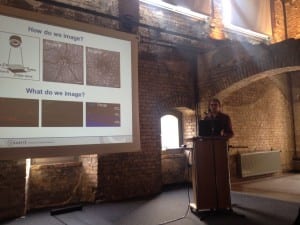 Microglia play a major role in retinal neovascularization and degeneration and are thus potential targets for therapeutic intervention. In vivo assessment of microglia behaviour in disease models can provide important information to understand patho-mechanisms and develop therapeutic strategies. Although scanning laser ophthalmoscope (SLO) permits the monitoring of microglia in transgenic mice with microglia-specific GFP expression, there are fundamental limitations in reliable identification and quantification of activated cells. Therefore, we aimed to improve the SLO-based analysis of microglia using enhanced image processing with subsequent testing in laser-induced neovascularization (CNV). CNV was induced by argon laser in MacGreen mice. Microglia was visualized in vivo by SLO in the fundus auto-fluorescence (FAF) mode and verified ex vivo using retinal preparations. Three image processing algorithms based on different analysis of sequences of images were tested. The amount of recorded frames was limiting the effectiveness of the different algorithms. Best results from short recordings were obtained with a pixel averaging altorithm, further used to quantify spatial and temporal distribution of activated microglia in CNV. Morphologically, different microglia populations were detected in the inner and outer retinal layers In CNV, the peak of microglia activation occurred in the inner layer at day 4 after laser, lacking an acute reaction. Besides, the spatial distribution of the activation changed by the time over the inner retina. No significant time and spatial changes were observed in the outer layer. An increase in laser power did not increase number of activated microglia. The SLO, in conjuction with enhanced image processing, is suitable for in vivo quantification of microglia activation. This surprisingly revealed that laser damage at the outer retina led to more reactive microglia in the inner retina, shedding light upon a new perspective to approach the immune response in the retina in vivo.
Microglia play a major role in retinal neovascularization and degeneration and are thus potential targets for therapeutic intervention. In vivo assessment of microglia behaviour in disease models can provide important information to understand patho-mechanisms and develop therapeutic strategies. Although scanning laser ophthalmoscope (SLO) permits the monitoring of microglia in transgenic mice with microglia-specific GFP expression, there are fundamental limitations in reliable identification and quantification of activated cells. Therefore, we aimed to improve the SLO-based analysis of microglia using enhanced image processing with subsequent testing in laser-induced neovascularization (CNV). CNV was induced by argon laser in MacGreen mice. Microglia was visualized in vivo by SLO in the fundus auto-fluorescence (FAF) mode and verified ex vivo using retinal preparations. Three image processing algorithms based on different analysis of sequences of images were tested. The amount of recorded frames was limiting the effectiveness of the different algorithms. Best results from short recordings were obtained with a pixel averaging altorithm, further used to quantify spatial and temporal distribution of activated microglia in CNV. Morphologically, different microglia populations were detected in the inner and outer retinal layers In CNV, the peak of microglia activation occurred in the inner layer at day 4 after laser, lacking an acute reaction. Besides, the spatial distribution of the activation changed by the time over the inner retina. No significant time and spatial changes were observed in the outer layer. An increase in laser power did not increase number of activated microglia. The SLO, in conjuction with enhanced image processing, is suitable for in vivo quantification of microglia activation. This surprisingly revealed that laser damage at the outer retina led to more reactive microglia in the inner retina, shedding light upon a new perspective to approach the immune response in the retina in vivo.